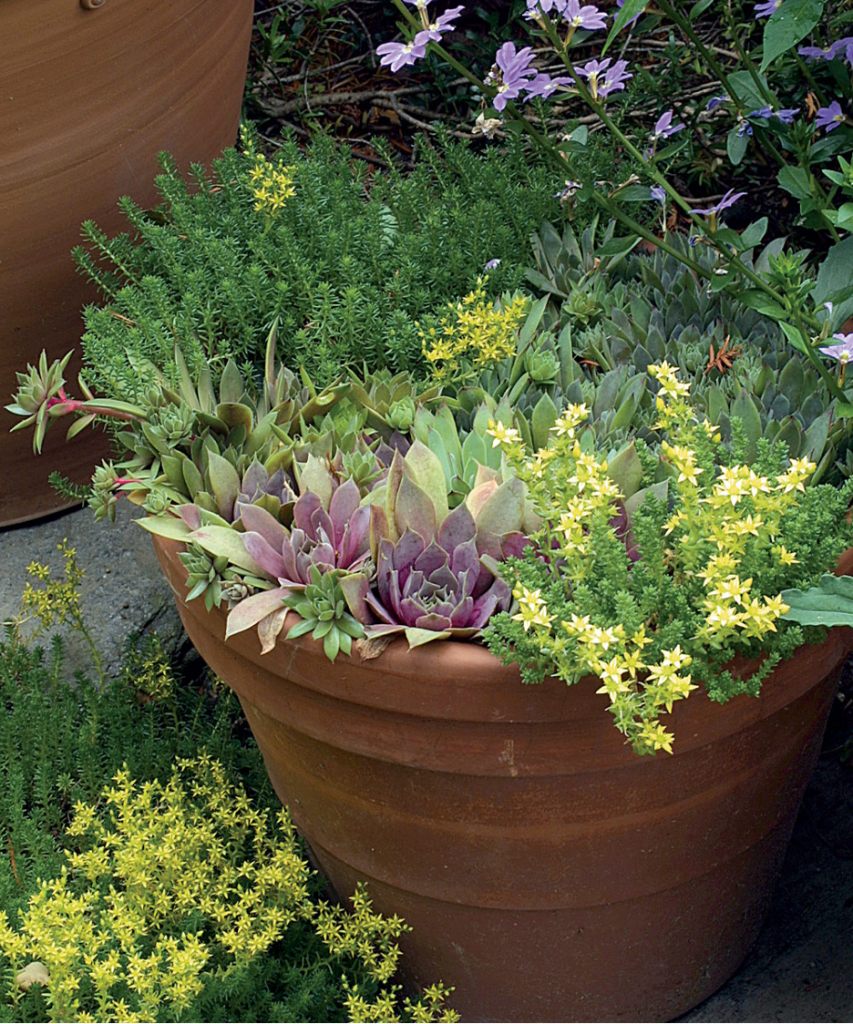
Coastal gardens evoke images of vibrant flowers and green native foliage bursting against a backdrop of cool ocean blues. But if your seaside property is small, or you don’t reside there year-round, you can still indulge in the joys of planting. Coastal container gardening offers an excellent solution for individuals living in coastal areas throughout the United States. Whether you reside on the East Coast, West Coast, or Gulf Coast, container gardening allows you to cultivate a variety of plants, even in limited spaces and challenging environments.
Coastal regions present unique conditions, including salt spray, sandy soil, and high winds, which require careful consideration when selecting plants for container gardening. So, we’ve done the work for you. Check out these six container gardening ideas tailored to thrive in coastal environments across the United States.
English Lavender (lavandula angustifolia)

Best Coastal Environments: Pacific Northwest, California Coast
Lavender is a versatile herb known for its fragrant blooms and drought tolerance, making it an ideal choice for coastal container gardening. In the Pacific Northwest and along the California coast, where maritime climates prevail, lavender thrives in well-drained soil and full sun. Its aromatic flowers attract pollinators, while its silver-gray foliage adds texture and beauty to coastal gardens.
Plant lavender in a large container with sandy, well-draining soil and place it in a sunny spot protected from strong winds. For more species recommendations and tips on planting lavender in pots, see this expert guide.
Agave (Agave spp.)

Best Coastal Environments: Gulf Coast states, Southern California, and parts of Central and Northern California
With more than 250 species, this popular succulent plant offers plenty of variety. Certain types, such as blue agave and green maguey, are best known as the essential ingredient for tequila and mezcal. Agave plants are well-suited to the arid conditions often found in coastal regions, particularly along the Gulf Coast states and Southern California. These succulents thrive in sandy soil and require minimal water, making them perfect for container gardening in coastal areas prone to drought.
Choose a variety of agave suitable for your specific climate and provide a container with excellent drainage to prevent waterlogging. Place the container in a sunny location where the agave can receive ample sunlight and good air circulation. For more tips on how to grow and care for Agave, visit The Spruce.
Windmill Palm (Trachycarpus fortunei)

Best Coastal Environments: East Coast, Florida
The windmill palm is a winter-hardy palm tree that can withstand harsher coastal conditions, including salt spray, strong winds, and cold temperatures. These qualities make it an excellent choice for container gardening along the East Coast and Florida. Also known as Chinese fan palm or Chusan palm, this frost-tolerant palm offers one of the hardiest tropical-looking trees.
This slow-growing plant features fan-shaped fronds and a slender trunk, adding a tropical touch to coastal landscapes. These sunbathers grow best in full or partial sun and thrive in temperatures reaching 65 to 75 degrees Fahrenheit. They can also survive temperatures dropping as low as 10 degrees Fahrenheit. Plant windmill palms in large containers filled with well-draining, acidic to neutral soil. Water every few days when newly planted, then once or twice weekly thereafter. For more tips, visit The Spruce.
Rosemary (Rosmarinus officinalis)

Best Coastal Environments: West Coast, Northeast Coast, New England
Rosemary is a perennial herb that thrives in coastal areas with cool, moist climates, such as those found along the West Coast, Northeast Coast, and New England. Its aromatic foliage and delicate blue-violet flowers offer an aesthetically pleasing choice for container gardening, where it can be grown year-round with proper care. Plant rosemary in a well-draining container with sandy soil and place it in a sunny location protected from strong winds. Water sparingly to prevent waterlogging, as rosemary prefers slightly dry conditions.
Remember to bring your rosemary containers indoors during the colder months, especially in the Northeast. Most varieties will not survive temperatures below 30 degrees but prefer temps between 55 and 80 degrees. To find out the best varieties for your region, talk to a local garden center professional or check out this helpful guide for tips on growing and caring for rosemary.
Sedum (Sedum spp.)

Best Coastal Environments: Most U.S. coastal regions, Great Lakes region
Sedums, also known as stonecrops, are drought-tolerant succulents that thrive in most coastal areas with variable weather conditions, even those in the Great Lakes region. Ideal for container gardening, these low-maintenance plants require minimal water and can tolerate poor soil quality. Choose from a variety of sedums suited to your specific climate and provide a container with good drainage to prevent waterlogging.
Many sedums prefer full sunlight, so be sure to place your containers in a sunny location where they can thrive. However, some varieties do better in sun and partial shade. Talk to a local nursery or garden professional to recommend sedum plants suitable for your coastal region. Check out this guide for some of the hardiest varieties.
Oleander (Nerium oleander)

Best Coastal Environments: Southern Coast, Gulf Coast
Oleander is a vibrant flowering shrub that adapts well to the hot, dry conditions often found along the southern coast and Gulf Coast, making it an excellent choice for container gardening in these regions. Its colorful blooms and evergreen foliage add beauty and interest to seaside landscapes, while its tolerance to salt spray and drought makes it a resilient choice for coastal gardens.
A native Mediterranean plant, Oleander, will not tolerate freezing temperatures, so growing it in pots offers a practical solution for many coastal climates. Plant oleander in a large container filled with well-draining soil and place it in a sunny location where it can receive full sunlight throughout the day. They can survive in partial shade but will not yield the colorful blossoms they produce in the sun. Even though they can withstand drought conditions, it’s essential to water them adequately.
So whether you’re a novice gardener or an experienced green thumb, here’s wishing you a flourishing coastal container garden by the beach.

